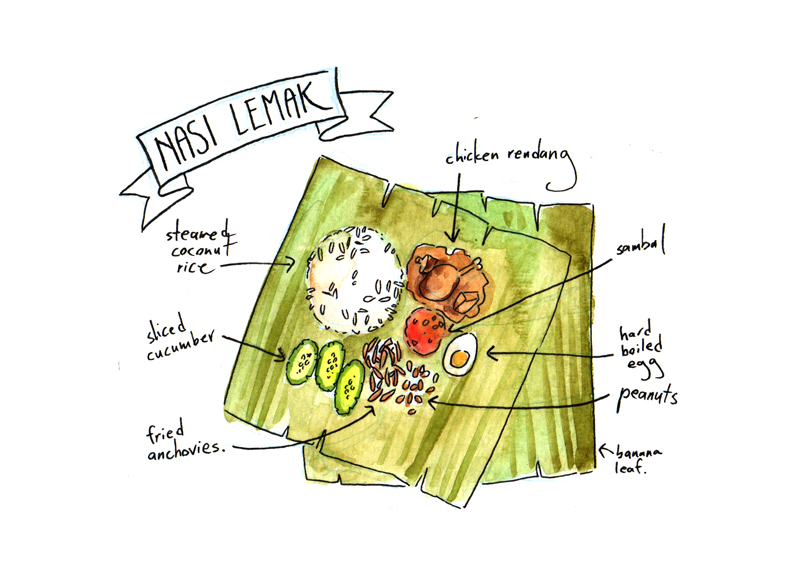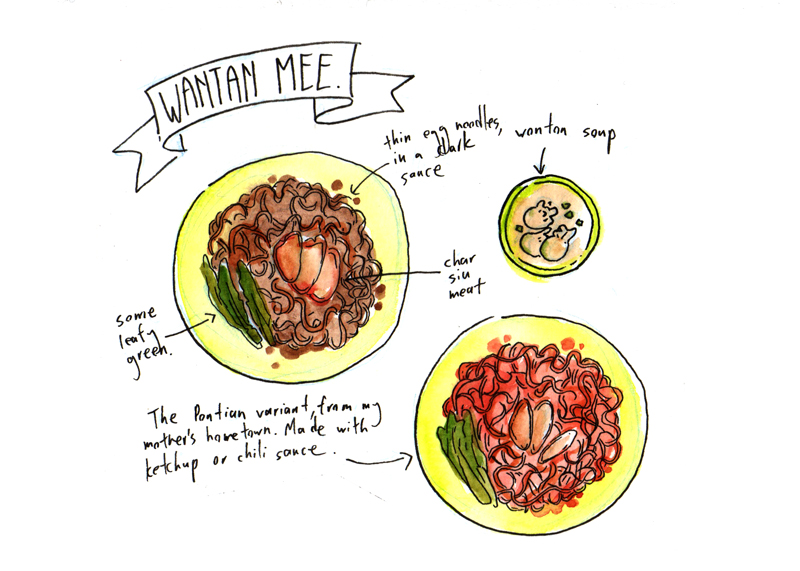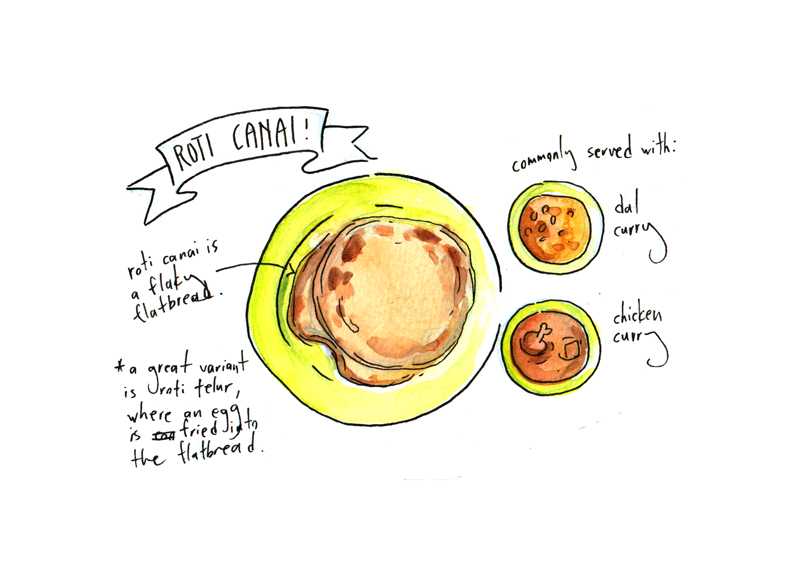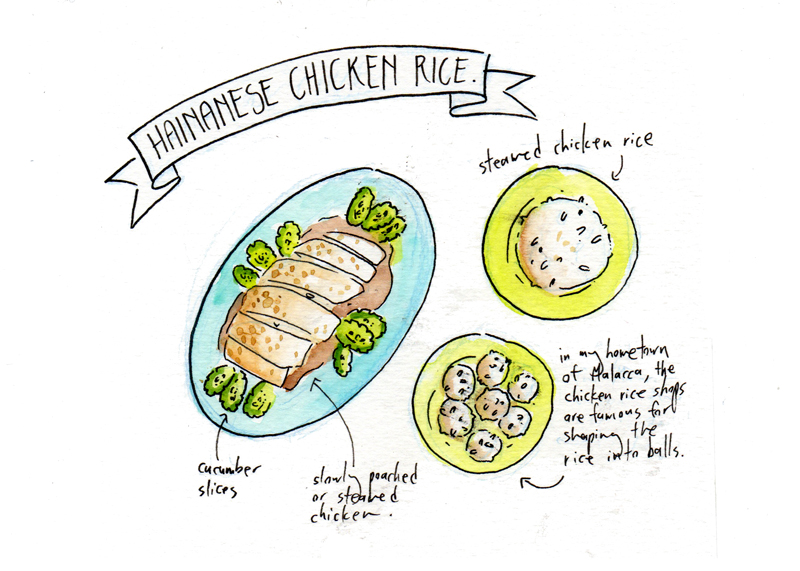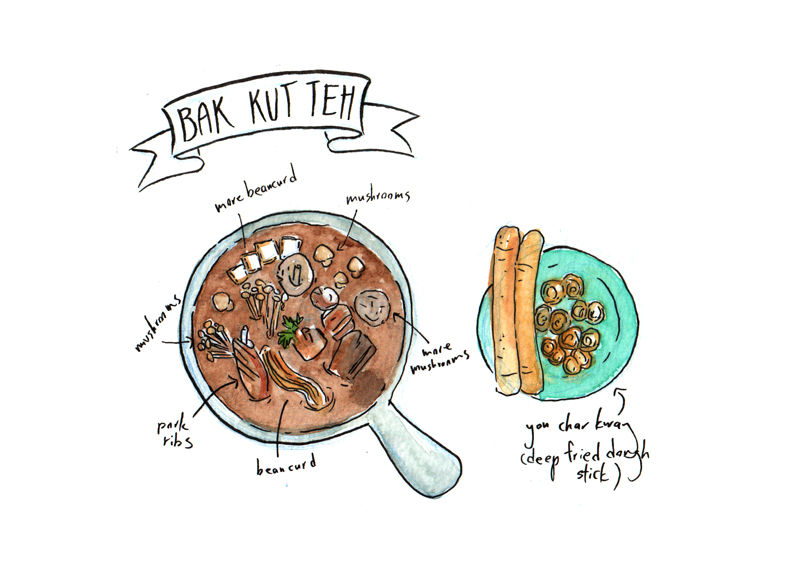I feel weirdly self conscious about writing about my home country, because I’ve been gone for so long, even if I still visit every two-three years or so. Still, during my last visit a couple months ago, I did a batch of drawings of my most favourite foods.
Nasi Lemak
When I was a kid, growing up in Malaysia, I ate nasi lemak in the most finicky way possible. I’d eat most of the rice, eat the peanuts and ikan bilis individually and save the cold cucumbers for last. I’d avoid everything spicy. I learned to love sambal and chicken curry in the Philippines, where my family and I were expats for six years, at a resort hotel restaurant that had a Malaysian chef that would make laksa for my dad, even though it wasn’t on the menu.
I still eat nasi lemak in a very finicky way, making sure each spoonful has the right balance of rice and sambal and curry. The ikan bilis and peanuts get eaten separately, still. The cucumbers are for when the spicy gets too spicy.
I’ve tried to cook the rice many times, and it hasn’t turned out right – the coconut milk affects the moisture and it sometimes ends up too dry or far too wet. I finally got it right with the recipe from the Lucky Peach cookbook(Lucky Peach Presents 101 Easy Asian Recipes), and being absolutely reliant on my rice cooker.
Wantan Mee
One of my favourite noodles of all time. The variant I love most is “Kon Lo Mee,” which is very much a Chinese Malaysian thing, made with dark sauce and char siew.
My brother, despite being super into eating healthy and low carb, will always make an exception for this, and easily eat three plates of it.
In my mom’s hometown of Pontian, there’s an amazing variant made with tomato ketchup and chili sauce.
Roti Canai
We’ve ordered roti canai at every Malaysian restaurant we’ve been to in the United States. It’s what all my friends fall in love with, and it’s hard for me to tell them that it’s still never quite right. It doesn’t matter whether the chef is Malaysian himself, whether he’s the son of a roti canai hawker, by the time it’s plated neatly and served as a $4.99 appetizer, it’s never quite right.
The closest we’ve found to the roti canai that my brain and tastebuds accept as roti canai is frozen, and found in some Korean markets in the Los Angeles area. It’s Raya’s “Puff Paratha” and we buy it in bulk and keep it in our freezer. I eat it the way I used to as a child, for breakfast, with lots of white sugar.
Hainanese Chicken Rice
This is an ultimate comfort food for me. It should be simple enough to make, but as all things that seem simple, I’ve never gotten it right.
In my hometown of Malacca, the rice is often served in pressed balls.
Bak Kut Teh
Another one I often try to make from home. It is best, after a while, to stop getting wrapped in notions of authenticity(which is, by the way, a myth), and start using delicious premixed spice and herb packets.
I feel like a thing you learn very quickly as an immigrant, especially in California, is which other countries have food that’s “close enough” to your own. Vietnamese bakeries make an excellent you char kway. Indonesian nasi bungkus is often close enough to nasi lemak. It’s a little odd sometimes, to talk to my traveler friends, and hear them opine on Southeast Asian foods. For them, discovering that this curry being similar to this other curry is an interesting tidbit. For me, it’s a nostalgic revelation, something that scratches an itch, an desperation to taste something that reminds me of what I grew up eating. It’s still never quite right, but close enough is close enough.

